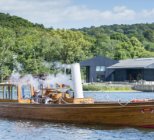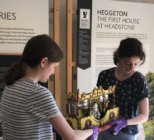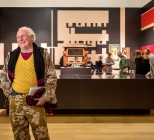In curating the ‘Understanding Your Visitors’ strand of the Museums + Heritage Show, Colin Mulberg’s brief was previously to zero in on gradual change in audience behaviours. Now, as the pandemic continues to redefine everything we know about the sector, he explores the lessons a year of lockdowns and isolation can teach industry decision makers.
Will it be viable for any sites to reopen with a ‘business as usual’ approach, and, if not, which alterations would current evidence suggest are here to stay?
Museums waiting for a return to ‘normal’ after Covid-19 are taking a huge risk. Visitors and visits may never go back to exactly how they were before the pandemic. Business planners are raising the question of whether the customers/visitors you left are the same as the ones you hope will return.
A key issue during the pandemic has been ‘in-home’ versus ‘out-of-home’ experiences. Users now have easy access to all manner of broadcasts, podcasts, webinars, videos, music, games, downloads and live streaming, along with more social media use and content.
There is a push to expand Virtual Reality and Augmented Reality in the domestic setting from a number of areas, including companies that wish to improve virtual meetings with their clients or when pitching for work, travel companies that need to entice travellers back to overseas visits, fashion companies that want to sell virtual products, and the gaming industry that is keen to expand its reach and income.
Museums and heritage venues can therefore expect even more competition to have their voices heard and their content seen. It may now be even harder to make money out of digital content and experiences as there will be much more choice, especially from players with bigger budgets.
When visitors do venture out, they want to leave their screens and the same four walls behind. They are looking for a totally different experience out-of-home; one that is uplifting, fulfilling, real and appeals to the senses and emotions in ways that experiences via a screen cannot.
Physical, dynamic and fun experiences are at a premium and the out-of-home experience is being valued as a key component in maintaining wellbeing and fighting social isolation. As life-work balances change, many people will reassess how they spend their leisure time and what they get back from different options.
Museums and heritage venues will need to be proactive to meet all these changes. If they stand still, visitors will find better offers that meet their agendas and will go elsewhere.
With the pandemic having rapidly accelerated a shift to expanded digital offers, what other changes in visitor wants and needs have been evidenced throughout the 2020/21 turmoil?
Indicators from the museums and heritage sector, along with tourism, travel, retail, leisure, home entertainment, attractions and creative industries, suggest there have been profound changes to visitor values, with an increased focus on family and friends as well as social and shared activity. This has accelerated the trend towards visitors wanting to invest in great experiences and creating memories. As one retail commentator put it, people want to ‘feel alive’ when they go out.
Though we do not know how long Covid-19 will be with us, it is unlikely that all of this change will disappear within a few months of museums, heritage and the rest of the economy opening up. Venues will need to match visitor values if they are to flourish.
With visitors seemingly more willing than ever to try innovative, experimental experiences, just how far can attractions go in pushing boundaries when they fully reopen?
There is plenty of scope for creative approaches to engaging visitors. In many respects the performing and creative arts have shouted the loudest and lead the way on this, and the museum and heritage sectors can learn from their adaptable approach.
Sculpture, art interventions, light installations and projections have appeared in unexpected ways, including in gardens and as city and park trails. Musicals and Shakespeare have been performed in pub gardens. An immersive drama on women’s five-a-side football was performed in an empty football stadium, using different locations for each scene. Drive-in cinema has become drive-in opera, theatre (with pizza delivered to your car boot), comedy (honk your horn if you like the joke) and even drive-in weddings (to by-pass social distancing restrictions). Museums and heritage venues are joining in, with drive-in exhibitions, collection-themed theatre and museum-based escape rooms/events.
Commercial landlords as well as designers and architects are predicting that there will be many empty offices and retail spaces, so there are possibilities to engage visitors beyond a venue’s walls.
The pandemic has also opened up the potential of partnerships. Many organisations report that they have needed to become more flexible in how they work with others and have formed partnerships in weeks instead of months. Creative partnerships can help deliver innovative approaches to developing visitor offers – museum and heritage venues do not have to do everything themselves.
Many audiences are open to trying new experiences and are forgiving of trials. They are becoming used to pop-ups appearing (and disappearing) and are not expecting everything to be polished as enterprises adapt to changing circumstances. There are opportunities to engage visitors in new and enticing ways with the right offer.
Will attractions be able to prioritise one specific type of offer or will it now be necessary to implement a hybrid approach – seeking a balance between the visitors desperate to get out and others nervous about mixing?
It is looking like there might be some fundamental changes in how and when people visit museums and heritage. Working patterns will probably shift, as many companies are looking at a hybrid model that splits office and homeworking. For example, Nationwide Building Society has announced that it will let its staff decide where they want to work and will investigate making office desks available at local branches.
Shopping patterns are also changing. A recent Barclaycard survey found that not only are people shopping more online, but many are shopping locally and keen to support local enterprises and say they are likely to continue.
Just these two changes have implications for museum and heritage venues. There could well be alterations in visiting patterns, as the working week changes and people spend more time locally. Transport planners are looking at busy periods only between Tuesday and Thursday, as people choose to work from home on Mondays and Fridays. There could be more demand for after-school or early evening visits with different types of activity on offer. Local audiences could become more important; the Art Newspaper predicted that the dearth of tourists will last four years for most large museums.
The types of experiences that visitors want may also change as people look to recharge their mental batteries during and after working or studying. They might also want visits of different durations that are still uplifting, so venues might need to think about giving quick dips as well as longer immersions. Even more than before, museum and heritage venues will need to fit in with the lives of their visitors and match their agendas.
Building relationships will be key, especially with local audiences to give them reasons to visit regularly. People have different notions of risk and so venues will need to cater for varying sentiments towards what feels safe and fulfilling. Visitor research will help develop audience insight and understanding as will learning lessons from reopening during different stages of lockdown.
Could we see a widespread departure from traditional gallery-hosted exhibitions and events into much greater focus of outdoor, open-air experiences?
This is an opportunity for museum and heritage organisations to make the most of everything they have. A starting place is to audit their whole sites, to see everything that could contribute to the visitor offer. This could include buildings, built heritage, courtyards, gardens, foyers, atriums, cafes, patios, views and vistas, other outdoor and indoor spaces, as well as traditional cased displays; all of these are assets that can be used for the benefit of visitors.
Developing a wider visitor offer will also reveal opportunities for income generation. One approach is to create a great standard visit and then to identify what things could be paid-for added value for particular audiences.
These extras could equally be linked to wellbeing as much as the collections. As budgets are probably going to be tight for the foreseeable future, museum and heritage organisations are likely to need varied visitor offers and a diversity of income streams.
Many visitors will be thinking in terms of value rather than cost. If they are to risk going out and mixing with other people as well as put time and effort into planning and visiting, they will want some clear payback in terms of enriching their lives, making them feel better and delivering tangible benefits.
For many people the pandemic has involved an intense and sustained focus on logistics and planning, so a variety of audiences will be attracted to packages, where the thinking and organising has been done for them – like the equivalent of a package holiday. Visitors book their whole visit in one go, including car parking, admission, food and drink, personal tours and experiences, downloadable visit guide, retail.
Intrigued by the ideas outlined in this Q&A or have examples of what your venue is doing to change its offer to visitors? Contact Colin via www.colinmulberg.com for a chat.










